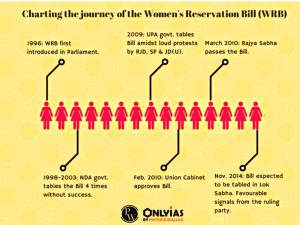Context: Recently, the Women Reservation Bill was introduced in Lok Sabha. The bill was introduced as the 128th Constitutional Amendment Bill.
| Relevancy for Prelims: Women Reservation Bill, Women Empowerment and Right to Equality.
Relevancy for Mains: Issue of Representation of Women in Politics, Women’s Issues, Inclusive Growth, Human Resource, Constitutional Provisions for Women Empowerment and Government Policies & Interventions. |
|---|

| Attempt the Mains Question: Q. Greater representation of women in the Indian parliament, through increased reservation will improve the status of Indian women. Comment (250 words, 15 Marks) |
|---|
Context: This article is based on an Editorial “India is at a pivotal moment in its health care journey” which was published in The Hindu. In the last few years, India has become a strong voice globally in climate change, electrification, new age manufacturing, and space race, however, India is also the world’s diabetes capital, millions have hypertension, and its youth are suffering from heart attacks, cancer, respiratory issues, depression and more.
| Relevancy for Prelims: Non-communicable diseases, achievement of India in Science & Technology and Artificial Intelligence (AI) in health care sector.
Relevancy for Mains: Issues related to development and management of health care, Potential of Artificial Intelligence (AI) in health care sector and achievement of India in Science & Technology. |
|---|
 Preventing India’s Lost Generation: There is an urgency to prevent NCD otherwise, India’s decade could turn into a generation of lost opportunity.
Preventing India’s Lost Generation: There is an urgency to prevent NCD otherwise, India’s decade could turn into a generation of lost opportunity.Context: This article is based on an Editorial “Crafting a new chapter in parliamentary conduct Premium” which was published in The Hindu. This article expresses the concerns over increasing disruptions in the Parliament of India, resulting in decreasing the efficiency of effective debates in the Parliament.
| Relevancy for Prelims: Prime Minister’s Question Time, Role of Speaker, Pivileger Motion, Opposition Day, Indian Parliamentary model and comparison with British Parliamentary System, Parliamentary conduct, Anti-Defection Law.
Relevancy for Mains: Decline of Parliamentary Democracy, Parliamentary Reforms and Explore the structure and functioning of the Indian Parliament, Bills and Legislation, Analyze the various parliamentary committees. |
|---|
For effective legislatures, it is necessary for the government and the opposition to maintain harmonious relations and work in a collaborative manner to ensure a smooth Parliamentary Conduct. Government needs to take steps to ensure opposition members to feel as valued members of an institution rather than irrelevancies.
<div class="new-fform">
</div>
